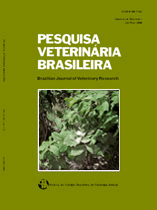 |
|
|
|
Year 1981 - Volume 1, Number 1
|

|
Intoxicação por Arrabidaea japurensis (Bignoniaceae) em bovinos em Roraima, p.7-17
|
ABSTRACT.- Tokarnia C.H. & Döbereiner J. 1981. [Poisoning of cattle by Arrabidaea japurensis (Bignoniaceae) in Roraima, northern Brazil.] Intoxicação por Arrabidaea japurensis (Bignoniaceae) em bovinos em Roraima. Pesquisa Veterinária Brasileira 1(1):7-17. Departamento de Nutrição Animal, Univ. Fed. Rural do Rio de Janeiro, Km 47, Seropédica, RJ 23460, Brazil.
The cause of “sudden death” in cattle in Roraima, northern Brazil, was investigated. These deaths, amounting to 1000-1500 annually, mainly occur when cattle are exercised; they are observed in farms of the “lavrado” region, situated along the large rivers of the area, specially rio Branco, Tacutu and Mucajaí, and less frequently the Uraricoera and Surumu rivers. Observations in the region and feeding trials in cattle identified Arrabidaea japurensis (DC.) Bur. & K. Schum. as the cause of “sudden death”. The fresh sprouts of the plant were given orally to 11 bovines in amounts that varied from 1.25 to 20 g of the plant per kilogram of body-weight. The amount of the plant necessary to cause death varied considerably; 10 g/kg always caused the death of the animais, but smaller doses down to 1.25 g/kg still caused the death of some. The first symptoms of poisoning were observed between 6 hours and 15 minutes and 22 hours and 10 minutes after the administration of the plant. Two of the four animals, which had eaten amounts of 10 g/kg or more, died of “sudden death” without having been exercised. The animais which had received smaller amounts, were driven between 18 and 22 hours after ingestion of the plant, and died suddenly after 1 to 45 minutes of exercise. The clinical signs lasted from 1 to 8 minutes; they were swaying gaint, muscular tremors, loss of stability and falling to the ground, peddling movements with the legs, sometimes moaning and intensive closing of the eyelids, and death. Post-mortem examinations were negative. Histopathologically there was hydropic vacuolar degeneration of the epithelial cells of the distal convoluted tubules in the kidney; this was seen in six of the eight animais which died due to the ingestion of the fresh plant material. Dried sprouts, given 3 and 6 months after they had been collected, had lost about half of their toxicity. The plant had no cumulative effects and did not induce tolerance. Mature leaves werw also toxic. |
| |
|
|
| |
|
 |